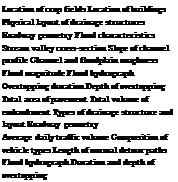Tangible costs in risk-based design
Design of a hydrosystem infrastructure, by nature, is an optimization problem consisting of an analysis of the hydraulic performance of the structure to convey flow across or through the structure and a determination of the most economical design alternative. The objective function is to minimize the sum of capital investment cost, the expected flood damage costs, and operation and maintenance costs. The relevant variables and parameters associated with the investment cost and the expected damage costs of a hydraulic structure, i. e., a highway drainage structure, are listed in Tables 8.1 and 8.2, respectively. The maintenance costs over the service life of the structure generally are treated as a yearly constants. Based on Tables 8.1 and 8.2, the information needed for the risk-based design of hydraulic structures can be categorized into four types:
1. Hydrologic/physiographic data include flood and precipitation data, drainage area, channel bottom slope, and drainage basin slope. These are needed to predict the magnitude of hydrologic events such as streamflow and rainfall by frequency analysis and/or regional analysis.
|
Pipe culverts |
Box culverts |
Bridges |
|
|
Parameters |
Unit cost of culvert |
Unit cost of concrete Unit cost of steel |
Unit cost of bridge |
|
Variables |
Number of pipes Pipe size Pipe length Pipe material |
Number of barrels Length of barrel Width of barrel Quantity of concrete Quantity of steel |
Bridge length Bridge width |
|
SOURCE: After Tung et al. (1993). |
|
TABLE 8.1 Variables and Parameters Relevant in Evaluating Capital Investment Cost of Highway Drainage Structures |
2. Hydraulic data include flood-plain slopes, geometry of the channel cross section, roughness coefficients, size of the structural opening, and height of the embankment. These are needed to determine the flow-carrying capacities of hydraulic structures and to perform hydraulic analysis.
TABLE 8.2 Damage Categories with Related Economic Variables and Site Characteristics in Risk-Based Design of Highway Drainage Structures



 |
|
 |
|
 |
Damage category Economic variables Site characteristics
SOURCE: After Tung and Bao (1990).
3. Structural data include material of substructures and layout of structure.
4. Economic data include (a) type, location, distribution, and economic value of upstream properties such as crops and buildings, (b) unit costs of structural materials, equipment, operation of vehicles, accidents, occupancy, and labor fee, (c) depth and duration ofovertopping, rate ofrepair, and rate ofaccidents, and (d) time of repair, and length of detour.
In the design of hydrosystem infrastructures, the installation cost often depends on environmental conditions, such as the location of the structure, ge – omorphic and geologic conditions, the soil type at the structure site, type and price of construction material, hydraulic conditions, flow conditions, recovery factor of the capital investment, and labor and transportation costs. In reality, these cost-affecting factors would result in uncertainties in the cost functions used in the analysis. However, a practical way to incorporate economic uncertainties in the risk-based design of hydrosystem infrastructures remains to be developed.






Leave a reply